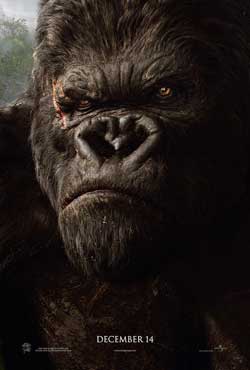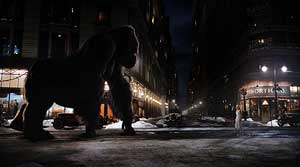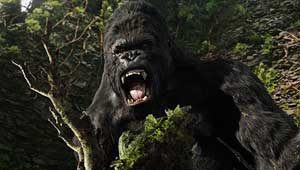 I belong to NYFCO, the New York Film Critics Online, and we had our annual awards meeting this past weekend. At the meeting someone nominated Andy Serkis for supporting actor for his work in King Kong. An argument broke out – is the guy really a supporting actor when he’s playing the titular ape? Unless of course we were talking about his role as Lumpy, the ship’s cook. Which we weren’t.
I belong to NYFCO, the New York Film Critics Online, and we had our annual awards meeting this past weekend. At the meeting someone nominated Andy Serkis for supporting actor for his work in King Kong. An argument broke out – is the guy really a supporting actor when he’s playing the titular ape? Unless of course we were talking about his role as Lumpy, the ship’s cook. Which we weren’t.
Sadly the question was moot, as Serkis didn’t get enough nomination votes to make it to the semi-finals. And he’ll probably be left out of the Oscars, like he was when he played Gollum in Lord of the Rings. But I have to tell you that when they finally do start giving out Oscars for Best Digital Character Performance, it’ll be called the Serkis Award, since this guy has broken all the ground. Just think – before Serkis the best known digital actor was Ahmed Best as Jar Jar Binks.
But what sets Serkis apart is his commitment to playing these characters not as special effects but as real, actual living things. Hell, he went to Rwanda to study real gorillas for this part. It’s amazing, and I think that King Kong with anyone else in that mocap suit just wouldn’t be the same film.
Q: We were told that the ice skating scene was actually your idea.
Serkis: We were experimenting with how Kong reacted to being put in the middle of Times Square once he jumps out of the theater. He knows where he’s going up until that point because he’s very focused on Jack, but when he bursts out of the theater, he’s suddenly in this environment which is freezing cold—as you know in New York, winter—and he’s got this slippery stuff that he’s never encountered before, having come from a tropical rain forest. So I started experimenting with him slipping and sliding and my original version on the motion capture stage was him slipping and spinning around, kind of gathering up all these cars and trucks and people in between his legs as he was spinning around. It was Peter’s idea to actually take that and make it into the scene between Ann and Kong which turned into this magical sort of moment in Central Park. It was originally going to be a Christmas tree and him playing with the lights—an innocence about it. So we transposed my idea and had Kong slipping on this slippery stuff, which you then found out was called ice, with the Anne Darrow character and that became their fleeting moment of reprieve.
Q: Can you talk about the time you spent in Rwanda and how involved you got with the animals? Where you ever in any danger?
Serkis: The story starts slightly before then, when I was working at London Zoo. I spent a lot of time at Regents’ Park Zoo, with the four gorillas there. There were three females and one male, and one of the females was called Zaire, who I particularly formed a relationship with. The thing about gorillas in captivity is that they reflect human behavior a lot more than gorillas in the wild. That was one of the things I was to discover. They’re surrounded by human beings from birth. Zaire—this gorilla—she chose me, she beckoned me over and we got on very, very well. The male of the group, Bob, didn’t like me at all. He intimidated me on a number of occasions. He didn’t really have the ability to be an alpha male because he had been brought up in a circus with chimpanzees, so he didn’t have the social etiquette to know how to be an alpha male for these three females. They found it frustrating, he found it frustrating, and I was in the middle. He used to take it out on me a bit. He threw a whole pile  of rubble right at me when I had my video camera on him and it scratched the lens.
of rubble right at me when I had my video camera on him and it scratched the lens.
So I spent two months at the zoo and then I had the chance to go to Rwanda. Seeing them in the wild is just another thing altogether. You’re watching them in big groups and you see the whole structure and hierarchy of a family in operation. And to have nothing between you and them is just phenomenal. I was with a research group. I was with the Diane Fosse Gorilla Fund International, who monitors their welfare. They’re habituated gorillas, so they’re used to human beings, but they didn’t know me. They spotted me immediately as the odd man in the group, because they hadn’t seen me before, and were very curious with me. You’re supposed to keep a seven-meter distance between you and them so that you don’t transmit human diseases. We share so much of the same genes that it’s very easy to transmit disease from us to them and that’s fatal because it can wipe out the whole group very, very quickly. So I had a paper mask and they were very curious about that. They would come up and sort of be very curious with me and one or two of them who were a bit more cheeky would come running past and give me a bit of a thump.
There was a charge by one silverback that took me so by surprise because they’re so fast and there’s very, very little warning. It’s all in the eyes and they avert their gaze and then suddenly they’re off. It’s like naught to sixty in nothing. Then they stand their ground and they’re very rigid and they strut and they rise up and beat their chest. They beat their chests with open hands, as opposed to clenched fists which is what they did in the original King Kong, because they have inflated chest sacs which, when they hoot, opens up. It sounds like a drum. They beat their hands seventeen times a second. That can be quite scary. You’re supposed to not move. You’re supposed to defer, but its all bluff. It’s all display, unless you transgress that and then you’re a fool.
Q: You’re really the first name in this kind of motion capture acting. Have you thought of the competitors, like Polar Express and I Robot?
Serkis: Gollum and Kong are both photo real characters. Of course, I Robot was as well. Polar Express was sort of different. It was much more paintily styled, much more animated, so it was slightly different to what we were doing. Although I think that was the first film to use facial motion capture for capturing actors’ facial performances. With this, obviously, it’s not trying to replicate a human face. The difference between the way we captured facial expressions with this, and Gollum is that with Gollum, my face was shot on 35mm film and the animators copied my facial expressions and key frame animated that. With this, it was directly from the 132 markers on my face, which then drove the CG face of Kong. Of course, the animators then enhanced that and augmented it, particularly a lot of muzzle movement because that’s very hard to do as a human being, the way the jaw moves and the way it’s connected to what’s called the “sagittal crest.”
The eyes, in particular, represent the acting choices that I’ve made and the whole physicality of the way Kong is and the way his personality is portrayed through performance capture.
Q: Who played the dinosaurs when you were directly fighting them?
Serkis: The T-Rex fight sequence is predominantly the animators’ domain. What we did was to facially motion capture the entire fight and then they basically took off my face and stuck it onto the key frame animated fight. I did some sequences with stunt men, but very little for the actual T-Rex fight. Some for when he’s hanging to get the physics of him actually hanging and trying to get back up and also the dramatic beats for the fight. Obviously, a fight sequence is also telling a story and there’s a progression through that. But all the stuff with Ann and the more static stuff, the more emotional stuff was more heavily motion captured.
fight sequence is also telling a story and there’s a progression through that. But all the stuff with Ann and the more static stuff, the more emotional stuff was more heavily motion captured.
Q: During the motion capture sequence when Kong was pushing Ann around, did you have a Naomi Watts doll to toss around?
Serkis: I did, actually. I had several different Barbie dolls, which were weighted with lead shot. There are two stages to creating a character. One is obviously the on set performance and working opposite Naomi. That was crucial for her performance and for synchronizing our performances so that we were playing very specific moments together. Peter’s prime aim to having an actor play Kong was so that the actress playing Anne Darrow didn’t have to imagine what Kong would be like. She wouldn’t have to make decisions for what he might be doing. I was doing those things and Naomi could respond to them. She, being the actress that she is, was phenomenally adept. She’s an amazing actress and wanted the connection. Had it been any other actress who wasn’t interested in forming a connection, but just wanted to do a performance by herself, I think it wouldn’t have worked because it is all about the connection between the characters.
The second part was, having shot the scenes on set with Naomi, when it came to the motion capture, I got a chance to experiment with the personality and the character of Kong. I would then work off of her close ups. I was looking down at monitors for the less physical scenes. I would play specifically to her shots. In that motion capture phase, which was two months after principal photography, I just gave them lots of choices in terms of performance, in how close Kong would be to human behavior and how close he would be to gorilla behavior and how he would express his emotions. We just experimented for weeks and weeks and weeks until we cracked the character. That’s the joy of working that way. You can just keep going and keep trying.
Q: As Lumpy, you got to have a glorious death. How did that develop? Serkis:I had to imagine all of that. I didn’t have the six-foot maggot thing there to play with, but I had some actors holding my arms and pulling me down and then I just had to imagine this huge Freudian thing suck the lifeblood out of me. But Lumpy’s the sort of character who’ll keep fighting to the last, even when he’s inside his head, he’d still think there’s a way out.
Serkis:I had to imagine all of that. I didn’t have the six-foot maggot thing there to play with, but I had some actors holding my arms and pulling me down and then I just had to imagine this huge Freudian thing suck the lifeblood out of me. But Lumpy’s the sort of character who’ll keep fighting to the last, even when he’s inside his head, he’d still think there’s a way out.
Q: Was it scripted like that, or did it develop on set?
Serkis:The animation director at the time was giving me a hint about what that thing might be doing, so I was just responding to that.
Q: Why did you choose to close Lumpy’s eye?
Serkis: It’s all to do with the fact that he’s spent years cooking and smoking a cigarette at the same time. The smoke always goes in his eyes.
Q: Was Kong far more difficult than the Gollum role?
Serkis: Immensely more difficult. So much of Gollum was his voice and the way he spoke. The character kind of emanated from this. He’s called Gollum because of the way he sounds and the physicality came out of the voice. I had to get myself into a certain physical position to make that voice really work. That was one of the biggest challenges. How were we going to convey that range of emotions with a mute character like Kong? A so-called mute. Of course, once I started researching gorillas and found out that they use a lexicon of vocalizations, that was a big key into it. We found out that they sing, they chuckle, they have very specific ways of communicating within a group. Just the breath, actually. On set, I had this sound system for Naomi to respond to, but on the motion capture stage, they recorded sound as well, so the sound is linked to the physicality. As the chest expands and contracts, you’d have that breath for real and being recorded, so there wasn’t ever a sense of it being an effect or a sound effect stuck on top. It was enhanced, of course. Its beefed up and very amazing things were done with the original sound that I’ve made, but it emanates from a living, breathing creature.
Someone described him, and I think it’s quite a cool way of looking at him, as an old, psychotic hobo. Although it’s a gorilla’s innate desire to connect with other beings, he’s just not used to it. The only contact he’s had is with creatures who are trying to attack him or threaten him. We found that Ann Darrow’s strength is humor. Her character is used to entertaining people and making people laugh and that’s her way of surviving. She engages Kong and gorillas have a sense of humor. They have a huge range of emotions and finding the humor there was a big key to the relationship.
entertaining people and making people laugh and that’s her way of surviving. She engages Kong and gorillas have a sense of humor. They have a huge range of emotions and finding the humor there was a big key to the relationship.
Q: You had a suit that guided some of your physical performance. What was it made out of?
Serkis: There were two suits that I wore. One on set was a gorilla muscle suit. That was for performance for me, really, to make me feel weightier and heavier. I used arm extensions some times and I wore gorilla dentures and I had a full sagittal crest. But it was the muscles as opposed to the fur. I wasn’t wearing a furry monkey suit. And then on the motion capture stage, I had a very skin tight, fitted suit so for all the markers to stay in one position and not move.
Q: What was your first reaction to seeing yourself on a 100-foot screen as a 25-foot gorilla?
Serkis: I’m still recovering from it really because I’ve lived and breathed every single moment of that character for such a long time now. I’ve seen it change incrementally from the motion capture puppet, to the renderings and the layers and the levels. Three weeks ago, it still wasn’t finished and I was putting the final vocal tracks on. I have to watch it again. It was such an assault on the senses all around. I’m really dying to see it again as quickly as possible. You just pick everything apart when you watch your own performances. It was very hard last night to get really emotionally carried along by it.
Q: Was there something, either while you were filming or after you were filming, that you were excited to see?
Serkis: The scene in the lair, which is a very quiet scene between her and Kong and there’s a slight unease about their relationship and she tries to attract his attention and then he’s looking out [at the sunset] and she says, “It’s beautiful.” Just the way that scene plays out and the way that she engages him and he eventually welcomes her. I remember that being very powerful on the day we shot and when I recreated it on the motion capture stage. That lived up to my expectations.
Q: Is there more motion capture in your acting career?
Serkis: For me, acting is acting and what I’ve done with Gollum and Kong is no different to any other character I’ve ever played. I don’t like to cut out a chunk of my flesh and blood mode, put it on a hanger and do a different type of acting. It’s just acting to me. It all has to do with character and script. If someone came up to me and said, “Here’s a great CG role,” and I read and I thought this script is amazing, it wouldn’t make any difference.